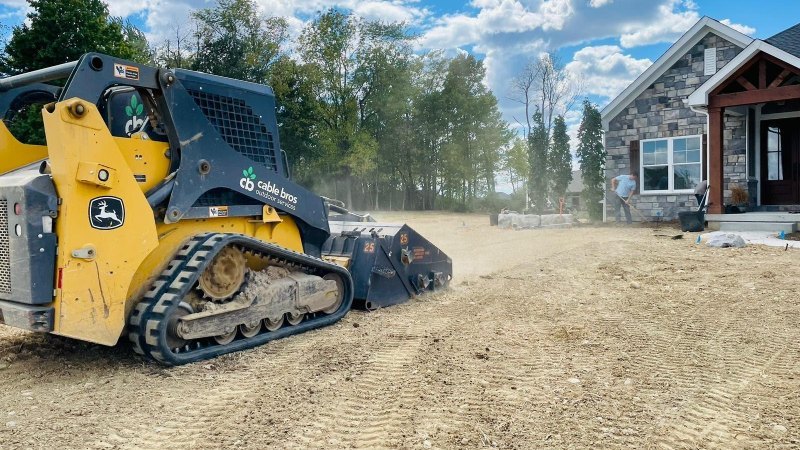
A well-planned landscape is more than just a collection of plants and pathways—it’s an extension of your home, an outdoor retreat that enhances curb appeal, boosts property value, and provides a peaceful escape. Whether you’re starting from scratch or looking to refresh your outdoor space, understanding the principles of designing landscape can help you achieve a beautiful, functional, and sustainable yard.
At Cable Bros Landscaping, we specialize in crafting outdoor spaces that blend aesthetics with functionality. To help you create the perfect landscape, here are ten essential tips to guide you through the process.
1. Plan with Purpose
Before breaking ground, take the time to define the purpose of your landscape. Ask yourself:
- Do you want a space for relaxation, entertaining, or gardening?
- Do you need a child- or pet-friendly design?
- Are you looking to increase privacy or improve curb appeal?
A well-thought-out plan ensures your landscape meets your lifestyle needs while maintaining a cohesive design.
2. Consider Your Climate and Soil Conditions
Not all plants thrive in every environment. Understanding your local climate, soil type, and sun exposure is essential for selecting plants that will flourish. Factors to consider include:
- Hardiness zone (ensuring plants can survive your region’s winters)
- Soil composition (sandy, clay, loamy)
- Sun and shade distribution throughout the day
Choosing the right plants for your specific environment will save time, effort, and money on maintenance.
3. Design for Year-Round Interest
A well-balanced landscape looks beautiful in every season. To achieve this, mix plants that offer different textures, colors, and bloom times. Consider incorporating:
- Spring: Tulips, daffodils, and cherry blossoms
- Summer: Vibrant perennials like lavender, daylilies, and coneflowers
- Fall: Maples, ornamental grasses, and chrysanthemums for rich autumn colors
- Winter: Evergreens, holly bushes, and decorative hardscaping to maintain visual appeal
A diverse selection of plants ensures your landscape stays lively throughout the year.
4. Balance Hardscape and Softscape Elements
An attractive landscape design combines both hardscape (non-living features) and softscape (plants and greenery) elements. Finding the right balance enhances both function and beauty. Examples include:
- Hardscape: Patios, walkways, retaining walls, fire pits, and outdoor kitchens
- Softscape: Trees, shrubs, flowers, and lawns
Incorporating a variety of materials—such as natural stone, wood, and water features—adds texture and depth to your outdoor space.
5. Create Focal Points
Every great landscape has a focal point that draws attention and provides a sense of structure. This could be:
- A statement tree (like a flowering dogwood or Japanese maple)
- A water feature (such as a pond or fountain)
- A sculpture or garden structure (like a pergola or arbor)
Focal points help guide the eye through the landscape and add character to your design.
6. Prioritize Functionality and Flow
A landscape should not only be beautiful but also practical and easy to navigate. To ensure a smooth flow between spaces:
✔ Use pathways to connect different areas and prevent wear on the lawn.
✔ Define outdoor rooms with seating areas, gardens, or dining spaces.
✔ Consider accessibility by adding wide walkways and level transitions.
A well-organized layout improves usability and makes your landscape more enjoyable.
7. Use Native and Drought-Tolerant Plants
Choosing native plants can reduce maintenance while supporting local ecosystems. Native species:
✔ Require less water and fertilizer
✔ Attract pollinators like bees and butterflies
✔ Adapt naturally to your soil and climate
For areas prone to drought, consider xeriscaping techniques, which emphasize low-water landscaping with succulents, ornamental grasses, and mulch to retain moisture.
8. Layer Plants for Depth and Dimension
To create a lush and dynamic landscape, use a layering technique:
- Tall plants and trees at the back or center of a garden bed
- Mid-sized shrubs and perennials for structure and variety
- Low-growing ground covers and flowers to fill in gaps and soften edges
This approach adds depth, making your yard appear larger and more inviting.
9. Add Outdoor Lighting for Beauty and Safety
Proper lighting enhances your landscape’s beauty and extends its usability into the evening. Consider incorporating:
✔ Pathway lights for safe navigation
✔ Accent lighting to highlight focal points like trees or sculptures
✔ String lights or lanterns to create ambiance in seating areas
Energy-efficient LED and solar-powered lighting options provide long-lasting illumination with minimal energy costs.
10. Maintain Your Landscape Regularly
Even the best-designed landscapes require ongoing maintenance to stay beautiful. Routine care includes:
✔ Pruning trees and shrubs to maintain shape
✔ Weeding and mulching to keep garden beds tidy
✔ Seasonal fertilization to promote healthy growth
✔ Keeping hardscapes clean and free of debris
With regular upkeep, your landscape will remain vibrant and inviting for years to come.
Start Your Landscape Transformation with Cable Bros Landscaping
Creating a stunning outdoor space requires careful planning, expert design, and quality execution. Whether you’re looking for a complete overhaul or simple enhancements, Cable Bros Landscaping has the experience and creativity to bring your vision to life.
If you’re ready to elevate your outdoor space with professional designing landscape services, our team is here to help. Contact us today to discuss your project and get started on transforming your yard into a breathtaking retreat!